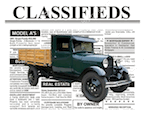Tech Q&A - Chassis - Steering
STEERING BOX OIL
Question:
An article was published recently in both club magazines that recommends using Ford steering gear grease in the Model A steering box. After fighting with a leaky box through three rebuilds this seems like a real good idea, but every source I have read states emphatically that oil, not grease must be used in the box. Also, in "Patent Cures" a while back the author suggested using a grease-oil mix in the box. Could I have your thoughts on this, please?
Answer:
That article has confused many people. I am in complete disagreement with the article. The grease talked about was formulated in 1963 and for steering gear boxes of that time. There was nothing indicating that it was appropriate for the square cut Model A type steering gear. Most gear boxes after 31 were helical cut and worked well with grease. The square cut two tooth sector will push the grease away from the worm and sector and cause more wear and eventually binding. There is only one way to fix your steering box oil leak. The two tooth worm and sector type (used primarily in the 1930/31 Model A's) has an after market end plate with tube that replaces the original end plate. The tube extends above the oil level in the gear box to prevent oil from leaking out the end of the steering column around the horn rod. The second place it leaks is around the sector shaft at the frame connection. This can be corrected by putting a new bushing in the sector housing.
Either install a new sector shaft or have your sector shaft turned down to eliminate wear in the shaft. Then install an over size ID bushing and ream and hone it to fit the shaft. Must obtain a fit of .001 to .0015" of shaft to bushing. Most sector shaft leaks are because there is from .002 to .005 clearance between shaft and bushing. A worn sector shaft will always leak. If someone has put needle bearings in the sector housing you will never get an oil seal. The needle bearing allows too lateral movement and causes the oil seal used with it to pull open, allowing oil to escape. Finally, place an "O" ring around the end of the sector shaft before bolting to the frame. This is the way I do it and have never had a problem with a steering oil leak. The 1928/29 with the 7- tooth worm and sector is fixed the same way at the sector shaft. At the end of the steering column there is a rubber seal that can be tightened around the horn rod. Hope this helps you. Let me know how it works out. -- Les Andrews, 1998 Technical Director
STEERING BOX OIL
Question:
"The Restorer" (July/August 1998) contains an article titled "Best Steering Gear Grease" by Herman Reheis. This article suggests using Ford part C3AZ19578-A steering gear grease for the Model "A" steering gear box.
In the same issue, you indicated that "You must use 600W oil in the steering box to reduce wear." This is in the "Tech Q & A" section. What is your opinion regarding the C3AZ19578-A? I thought that grease would be forced out of the steering gear teeth and not lubricate properly.
Answer:
You're not the first to hit me with this one. Sorry about the confusion on the steering grease article. I did not agree with the article. That grease was developed in 1963 for the gear boxes of the time. After the 40's all gear boxes were made with a helical cut steering gear. Grease works fine in a helical cut gear. The Model A has a square cut sector that will push the grease away from the worm allowing for more wear. I still believe that heavy oil is the best lubricant for the Model A gear box. I hesitated about allowing the article to run and should have listened to my thoughts. It is contradictory. I'm sure I will hear more about this one. The recommendation came from George De Angelis who has always been a long time authority on the Model A, but I don't think he took into consideration that it was engineered in 1963 (by a Ford Engineer) and not for the Model A gear box. I stand by the 600W oil for the Model A gear box. Sorry for the confusion. -- Les Andrews, 1998 Technical Director
STEERING GEARS
Question:
I'm overhauling my 2-tooth steering gear for my '30 Tudor. I accidentally broke off the threads on the steering shaft so I'm using a shaft from a 2nd column I bought a while back. After disassembling this 2nd column, I found the worm gear is copper colored. Is this a sign of excess wear? It appears on most of the gear, not just on the bearing surfaces. The housing was filled with grease not 600 weight oil, so is it a possible staining from that? There is also a rust pit on one area of the worm, can this be filled w/weld & filed smooth? Its not on bearing area, but where sector tooth will touch. Or can I just leave it as is? Spot is about 1/8" or smaller. It's not the early 2 tooth design as far as I can tell, there's no shoulder on the lower bearing surface.
Answer:
The copper colored worm gear is OK. Many of the original worm gears had a copper coating. As long as the rust pit is NOT on the bearing race surface of the worm I would leave it alone. No need to fill if the pits are not too deep. The sector tooth is wide enough it probably will never feel the small rust pits. File off any raised areas caused from rust. Be sure to replace the sector shaft bushings and use 600W oil in the gear box. Measure the Sector Shaft for wear. The original sector shaft measured 1.125" diameter. You should replace it if more than .002 ". Otherwise you will have a problem with oil leaking out of the sector shaft housing.
STEERING BOX REASSEMBLY
Question:
I have a two tooth steering column and am in the process of rebuilding it. I have installed new bearings and completely cleaned it up. My question is: I ordered new parts and in them was a rubber seal or gasket. I have a schematic of the column but do not know where this rubber washer goes in sequence.
Answer:
This rubber washer was originally made of cork. It inserted into the bottom end of the housing to form a seal around the horn rod as it came out the end, then a metal plate with ears to attach the bail wire for the light switch, and then the light switch bracket attaches with two bolts to hold it all together. I suggest that you toss the rubber washer and metal plate with two ears. Replace with an oil tube plate. This is a plate that looks like the one with two ears, but has a tube (about 4" long) welded in the center. Attach with a paper gasket on the bottom side. The horn rod goes through the tube and the tube is well above the oil level in the steering box so makes for an excellent oil seal. You can find this well illustrated and described the MODEL A FORD MECHANICS HANDBOOK. You may want to look it up in the book before proceeding. -- Les Andrews, 1998 Technical Director
STEERING WHEEL
Question:
Has anyone else had this problem: when the black steering wheel in my '29 coupe gets wet....like condensation in the morning in cool weather...it "sweats" black sticky moisture. Does anyone know what would stop this? Or what might cause it?
Answer:
The steering wheel has lost it protective coating. Your can try repainting it...but replacing it will probably be the best answer. -- Lyle Meek, 1997 Technical Director
STEERING WHEEL REMOVAL
Question:
Now I've done it. In trying to remove my steering wheel from the shaft, I've broken off the entire threaded portion of the shaft. I've heard this can be repaired, but what's the procedure? What thread pitch is it? Any help would be GREATLY appreciated!
Answer:
The steering shaft has a 5/8-18 thread. I have been rebuilding and repairing steering columns for a long time. I do not know of a reliable way to re attach the threaded end. Your problem is not uncommon. The steering shaft for the two-tooth steering was made considerably smaller in diameter than was used on the 28/29 7-tooth steering. That's why they went from a splined shaft to a tapered and keyed shaft.
You have but two choices. 1) If you have as many as three (3) threads left you can use LockTite on the threads and just snug the nut down. The shaft is tapered and has a woodruff key to hold it in place. If you don't feel comfortable with that, you should remove the steering column and replace the steering shaft and worm. You can pick up steering columns at swap meets for $20.00 to $40.00, depending on condition. Make sure it has a tapered and keyed shaft and that the top threads are good. There are three different lengths so measure yours to make sure you get the right length. When you install a replacement, only snug down the steering wheel nut and use LockTite. There are no new steering shafts being made. -- Les Andrews, 1998 Technical Director





